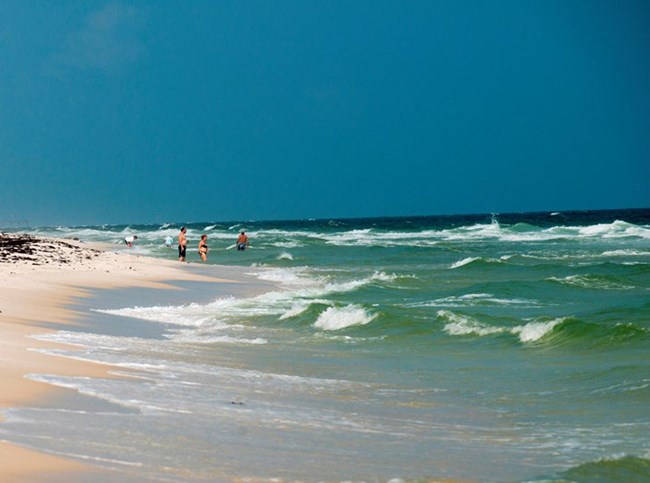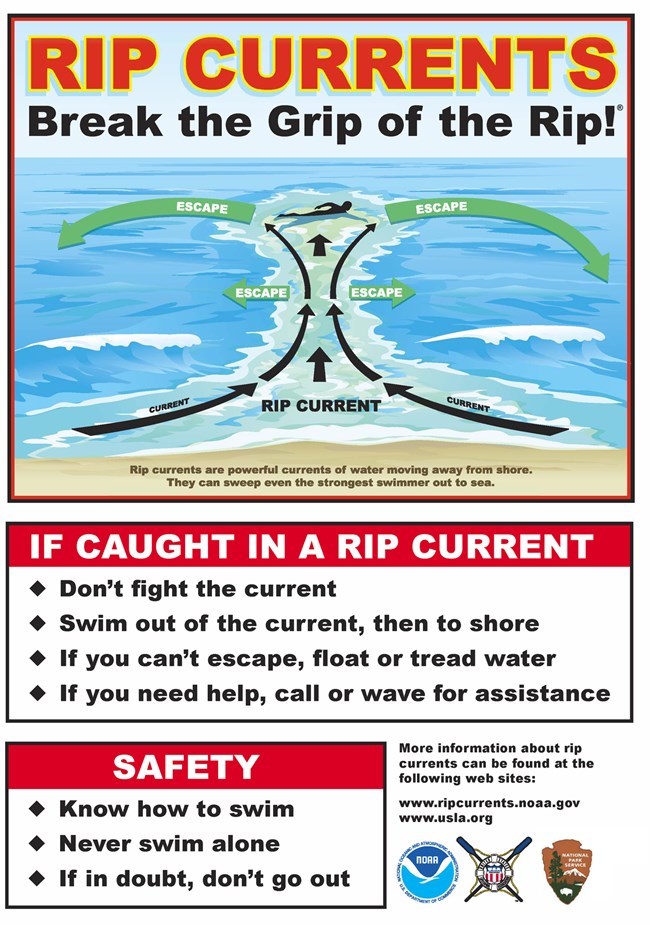Part of a series of articles titled Coastal Geohazards.
Article
Coastal Geohazards—Dangerous Currents

Rip Currents
Rip currents are powerful, narrow channels of water that flow away from the shore. Rip currents occur along the Atlantic, Pacific, Arctic, and Gulf of Mexico coasts of the United States, as well as along the shores of the Great Lakes. These currents (often incorrectly called rip tides) can flow up to 8 ft per second (2.4 m/s), which is faster than the average person can swim.
Rip currents are created due to set-up near the shoreline. Set-up is a slight increase in water levels compared to those found seaward of the surf zone. Set-up creates unstable conditions that are eventually relieved through the formation of rip currents. These dangerous currents generally form at a low point in a sandbar. Swimmers should be especially cautious during storm events, which may increase the frequency and strength of rip currents.

Before going into the ocean, check for these signs of a rip current:
- A channel of churning, choppy water.
- An area having a notable difference in water color.
- A line of foam, seaweed, or debris moving steadily seaward.
- A break in the incoming wave pattern.
What to do if you get caught in the grip of a rip current:
- Yell for help immediately.
- Don’t swim against a rip current – it will just tire you out.
- Escape the rip current by swimming parallel to the beach until you are free.
- If you are unable to swim out of the rip current, float or calmly tread water.
- When out of the current, swim toward the shore at an angle away from the rip current.
Rip currents are not the only dangerous currents found at the coast:
- Structural currents can form alongside piers or jetties. These currents will move seaward parallel to the structure. To help stay safe, avoid swimming near or jumping off piers and jetties.
- Outlet Currents may be found where rivers enter an ocean or lake. The flow of water continues seaward and can become dangerous when large. To escape, swim perpendicular to the current, or parallel with the shore.
- Longshore currents move parallel to the shore. A swimmer may notice they are in a longshore current if it is difficult to remain in front of one spot on the beach. Longshore currents become more dangerous as they sweep down the beach into an unexpected rip, outlet, or structural current.
- Channel Currents run parallel to the shore and form near island like structures or piles of rocks. Here, the flow of water increases in speed as it bottlenecks between the structure and the shore. The channel current will become stronger if it passes over a sandbar and builds pressure. If caught in a channel current, it is advised to swim to the shore, not the sandbar (Michigan Sea Grant).
Related Links
-
Assateague Island National Seashore, Maryland and Virginia [Geodiversity Atlas] [Park Home]
-
Golden Gate National Recreation Area, California [Geodiversity Atlas] [Park Home]
-
Indiana Dunes National Lakeshore, Indiana [Geodiversity Atlas] [Park Home]
-
Padre Island National Seashore, Texas [Geodiversity Atlas] [Park Home]
Last updated: September 10, 2018
